Verification of Particle Tracking and In Situ Tracer Experiment for the Gravel and Cholan Formation Composite in Northwest Taiwan
Abstract
:1. Introduction
2. Methods
2.1. Continuum and Discrete Approach
2.2. Hydrogeological Conceptual Model
2.3. Groundwater Flow Simulation
2.4. Particle Tracking Algorithm
3. In Situ Tracer Experiment and Site Descriptive Model
3.1. In Situ Tracer Experiment
3.2. Site Descriptive Model
4. Results and Discussion
4.1. Particle Travel Length of Different Models
4.2. Particle Travel Time of Different Models
4.3. Transport Resistance of Different Models
4.4. Comparative Analysis of Numerical Simulation and Tracer Test Results
4.5. Sensitivity Analysis of Rock Hydraulic Conductivity in Various Formation
5. Conclusions
Author Contributions
Funding
Data Availability Statement
Conflicts of Interest
References
- Constantz, J.; Cox, M.H.; Su, G.W. Comparison of heat and bromide as ground water tracers near streams. Ground Water 2003, 41, 647–656. [Google Scholar] [CrossRef] [PubMed]
- Cox, M.H.; Su, G.W.; Constantz, J. Heat, chloride, and specific conductance as ground water tracers near streams. Ground Water 2007, 45, 187–195. [Google Scholar] [CrossRef]
- Ma, R.; Zheng, C.; Zachara, J.M.; Tonkin, M. Utility of bromide and heat tracers for aquifer characterization affected by highly transient flow conditions. Water Resour. Res. 2012, 48, W08523. [Google Scholar] [CrossRef]
- Benson, R.C.; Yuhr, L.B. Site Characterization in Karst and Pseudokarst Terraines: Practical Strategies and Technology for Practicing Engineers, Hydrologists and Geologists, 1st ed.; Springer: Dordrecht, The Netherlands, 2015; pp. 275–293. [Google Scholar]
- Dierberg, F.E.; Juston, J.J.; DeBusk, T.A.; Pietro, K.; Gu, B. Relationship between hydraulic efficiency and phosphorus removal in a submerged aquatic vegetation-dominated treatment wetland. Ecol. Eng. 2005, 25, 9–23. [Google Scholar] [CrossRef]
- Bowman, R.S. Evaluation of some new tracers for soil water studies. Soil Sci. Soc. Am. J. 1984, 48, 987–992. [Google Scholar] [CrossRef]
- Whitmer, S.; Baker, L.; Wass, R. Loss of bromide in a Wetland tracer experiment. Environ. Qual. 2000, 29, 2043–2045. [Google Scholar] [CrossRef]
- Flury, M.; Papritz, A. Bromide in the natural environment: Occurrence and toxicity. J. Environ. Qual. 1993, 22, 747–758. [Google Scholar] [CrossRef]
- Löfgren, M.; Crawford, J.; Elert, M. Tracer Tests-Possibilities and Limitations, Experience from SKB Fieldwork: 1977–2007; SKB R-07-39; Swedish Nuclear Fuel and Waste Management Co.: Stockholm, Sweden, 2007; pp. 35–103. [Google Scholar]
- Yu, Y.-C.; Lee, I.-H.; Ni, C.-F.; Shen, Y.-H.; Tong, C.-Z.; Wu, Y.-C.; Lo, E. Numerical Assessment of the Hybrid Approach for Simulating Three-Dimensional Flow and Advective Transport in Fractured Rocks. Appl. Sci. 2021, 11, 10792. [Google Scholar] [CrossRef]
- Hyman, J.D.; Painter, S.L.; Viswanathan, H.; Makedonska, N.; Karra, S. Influence of injection mode on transport properties in kilometer-scale three-dimensional discrete fracture networks. Water Resour. Res. 2015, 51, 7289–7308. [Google Scholar] [CrossRef]
- Painter, S.; Cvetkovic, V.; Mancillas, J.; Pensado, O. Time domain particle tracking methods for simulating transport with retention and first-order transformation. Water Resour. Res. 2008, 44, 1–11. [Google Scholar] [CrossRef]
- Gingold, R.A.; Monaghan, J.J. Smoothed particle hydrodynamics: Theory and application to non-spherical stars. Mon. Not. R. Astron. Soc. 1977, 181, 375–389. [Google Scholar] [CrossRef]
- Herrera, P.A.; Massabó, M.; Beckie, R.D. A meshless method to simulate solute transport in heterogeneous porous media. Adv. Water Resour. 2009, 32, 413–429. [Google Scholar] [CrossRef]
- Liu, M.B.; Liu, G.R. Smoothed Particle Hydrodynamics (SPH): An overview and recent developments. Arch. Comput. Methods Eng. 2010, 17, 25–76. [Google Scholar]
- Berkowitz, B.; Bear, J.; Braester, C. Continuum models for contaminant transport in fractured porous formations. Water Resour. Res. 1988, 24, 1225–1236. [Google Scholar] [CrossRef]
- Pruess, K.; Tsang, Y.W. On two-phase relative permeability and capillary pressure of rough-walled rock fractures. Water Resour. Res. 1990, 26, 1915–1926. [Google Scholar] [CrossRef]
- Royer, P.; Auriault, J.L.; Lewandowska, J.; Serres, C. Continuum modelling of contaminant transport in fractured porous media. Transp. Porous Media 2002, 49, 333–359. [Google Scholar] [CrossRef]
- Reimus, P.; Pohll, G.; Mihevc, T.; Chapman, J.; Haga, M.; Lyles, B.; Kosinski, S.; Niswonger, R.; Sanders, P. Testing and parameterizing a conceptual model for solute transport in a fractured granite using multiple tracers in a forced-gradient test. Water Resour. Res. 2003, 39, 1356–1371. [Google Scholar] [CrossRef]
- Long, J.C.S.; Remer, C.R.; Wilsion, C.R.; Witherspoon, P.A. Porous media equivalents for networks of discontinuous fractures. Water Resour. Res. 1982, 18, 645–658. [Google Scholar]
- Wu, Y.S.; Ritcey, A.C.; Bodvarsson, G.S. A modeling study of perched water phenomena in the unsaturated zone at Yucca Mountain. J. Contam. Hydrol. 1999, 38, 157–184. [Google Scholar] [CrossRef]
- Hartley, L.; Joyce, S. Approaches and algorithms for groundwater flow modeling in support of site investigations and safety assessment of the Forsmark site, Sweden. J. Hydrol. 2013, 500, 200–216. [Google Scholar] [CrossRef]
- Tsang, Y.W.; Tsang, C.F. Channel model of flow through fractured media. Water Resour. Res. 1987, 23, 467–479. [Google Scholar] [CrossRef]
- Cacas, M.C.; Ledoux, E.; de Marsily, G.; Barbreau, A.; Calmels, P.; Gaillard, B.; Margrita, R. Modeling fracture flow with a stochastic discrete fracture network: Calibration and validation, 2, The transport model. Water Resour. Res. 1990, 26, 491–500. [Google Scholar] [CrossRef]
- Oda, M. Permeability tensor for discontinuous rock masses. Geotechnique 1985, 35, 483–495. [Google Scholar] [CrossRef]
- Dendys, M.; Szczepański, A.; Tomaszewska, B. Groundwater circulation in the Miechów trough and the central part of the Carpathian Foredeep (Poland): A hydrogeological conceptual model. Geologos 2018, 24, 177–187. [Google Scholar] [CrossRef]
- Dershowitz, W.S.; La-Pointe, P.R.; Doe, T.W. Advances in discrete fracture network modeling. In Proceedings of the US EPA/NGWA Fractured Rock Conference, Portland, ME, USA, 13–15 September 2004; pp. 882–894. [Google Scholar]
- Miller, I.; Lee, G.; Dershowitz, W.S. MAFIC Matrix/Fracture Interaction Code with Heat and Solute Transport—User Documentation, version 2.0; Golder Associates Inc.: Redmond, DC, USA, 2001; pp. 1–88. [Google Scholar]
- Smith, L.; Schwartz, F.W. An analysis of the influence of fracture geometry on mass transport in fractured media. Water Resour. Res. 1984, 20, 1241–1252. [Google Scholar] [CrossRef]
- Hull, L.C.; Miller, J.D.; Clemo, T.M. Laboratory and simulation studies of solute transport in fracture networks. Water Resour. Res. 1987, 23, 1505–1513. [Google Scholar] [CrossRef]
- Brewster, B.S.; Cannon, S.M.; Farmer, J.R.; Meng, F. Modeling of lean premixed combustion in stationary gas turbines. Prog. Energy Combust. Sci. 1999, 25, 353–385. [Google Scholar] [CrossRef]
- Makedonska, N.; Painter, S.L.; Bui, Q.M.; Gable, C.W.; Karra, S. Particle tracking approach for transport in three-dimensional discrete fracture networks. Comput. Geosci. 2015, 19, 1123–1137. [Google Scholar] [CrossRef]
- Pollock, D.W. User Guide for MODPATH Version 7—A Particle Tracking Model for MODFLOW; Open-File Report 2016–1086; U.S. Geological Survey: Reston, VA, USA, 2016. [Google Scholar]
- Svensson, U.; Kuylenstierna, H.-O.; Ferry, M. DarcyTools version 3.4–Concepts, Methods and Equations; SKB R-07-38; Swedish Nuclear Fuel and Waste Management Co.: Stockholm, Sweden, 2010; pp. 1–36. [Google Scholar]
- Zheng, C. Analysis of particle tracking errors associated with spatial discretization. Groundwater 1994, 32, 821–828. [Google Scholar] [CrossRef]
- Crawford, J.; Kemakta Konsult, A.B. Modelling in Support of Bedrock Transport Property Assessment. Preliminary Site Description Laxemar Subarea, version 1.2; SKB R-06-28; Swedish Nuclear Fuel and Waste Management Co.: Stockholm, Sweden, 2006; pp. 28–32. [Google Scholar]
- Yu, Y.-C.; Shen, Y.-H.; Lee, T.-P.; Ni, C.-F.; Lee, I.-H. Numerical Assessments of Flow and Advective Transport Uncertainty for Performance Measures of Radioactive Waste Geological Disposal in Fractured Rocks. Energies 2022, 15, 5585. [Google Scholar] [CrossRef]
- Yu, Y.C.; Chen, C.J.; Chung, C.C.; Ni, C.F.; Lee, I.H.; Wu, Y.C.; Lin, T.Y. A multimodel framework for quantifying flow and advective transport controlled by earthquake-induced canister failures in a reference case for radioactive waste geological disposal. Energies 2023, 16, 5081. [Google Scholar] [CrossRef]
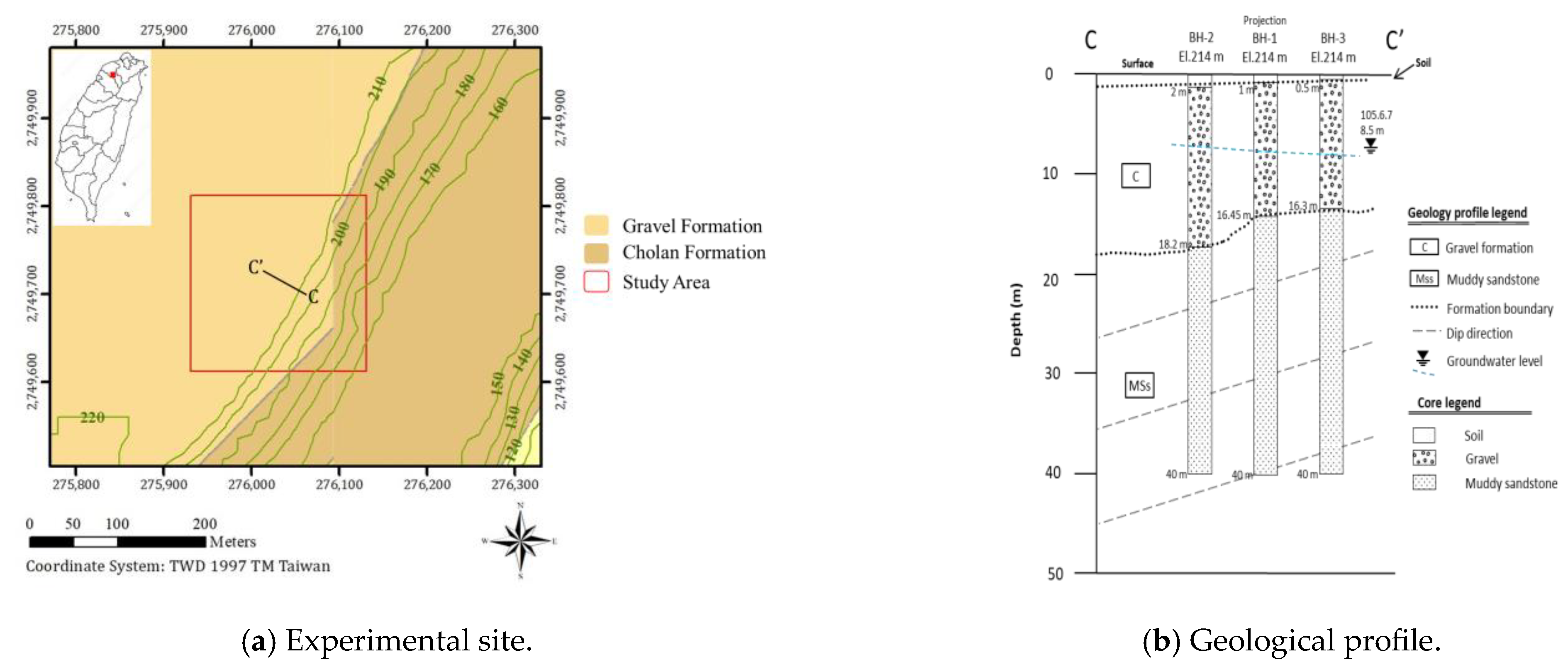


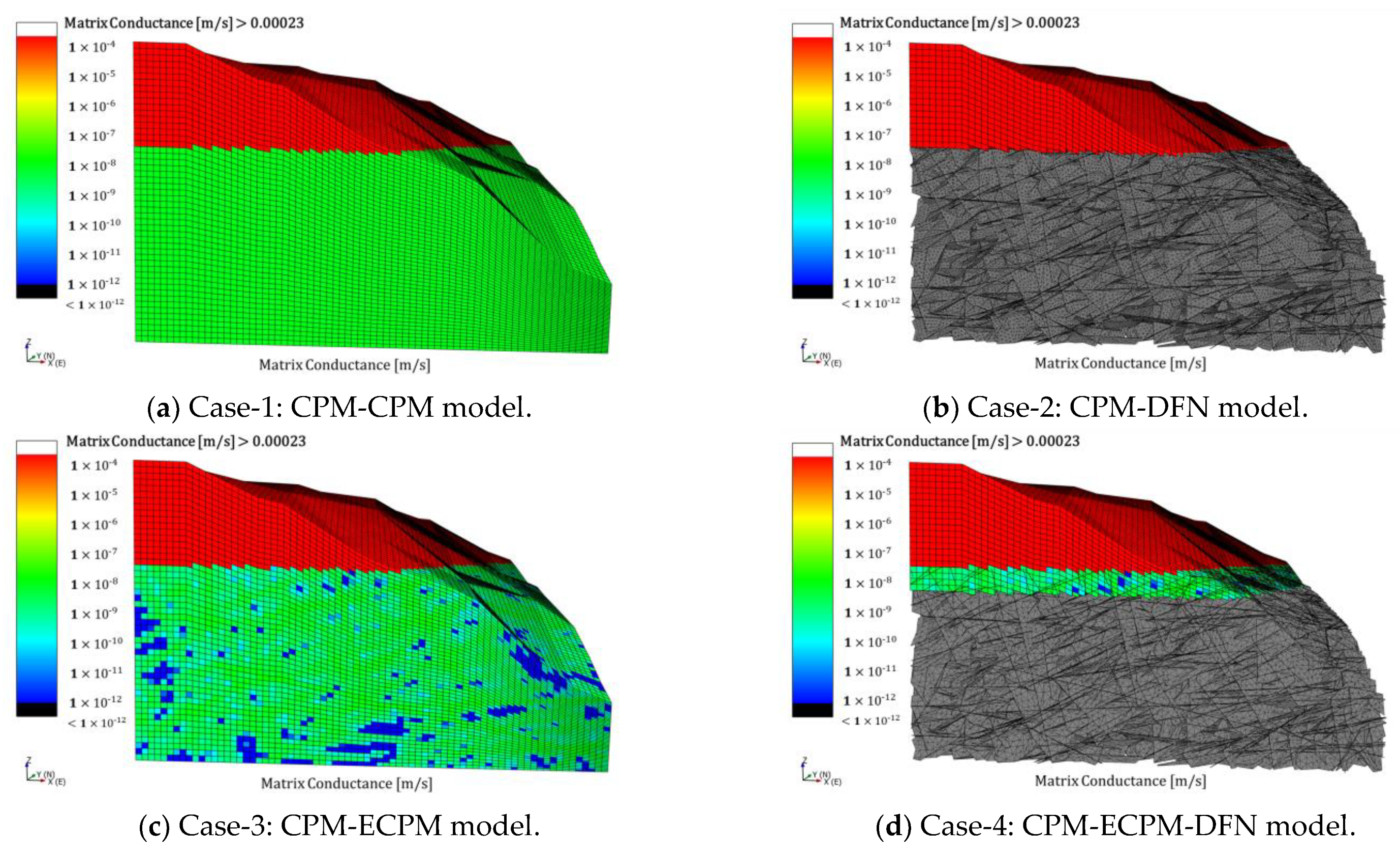
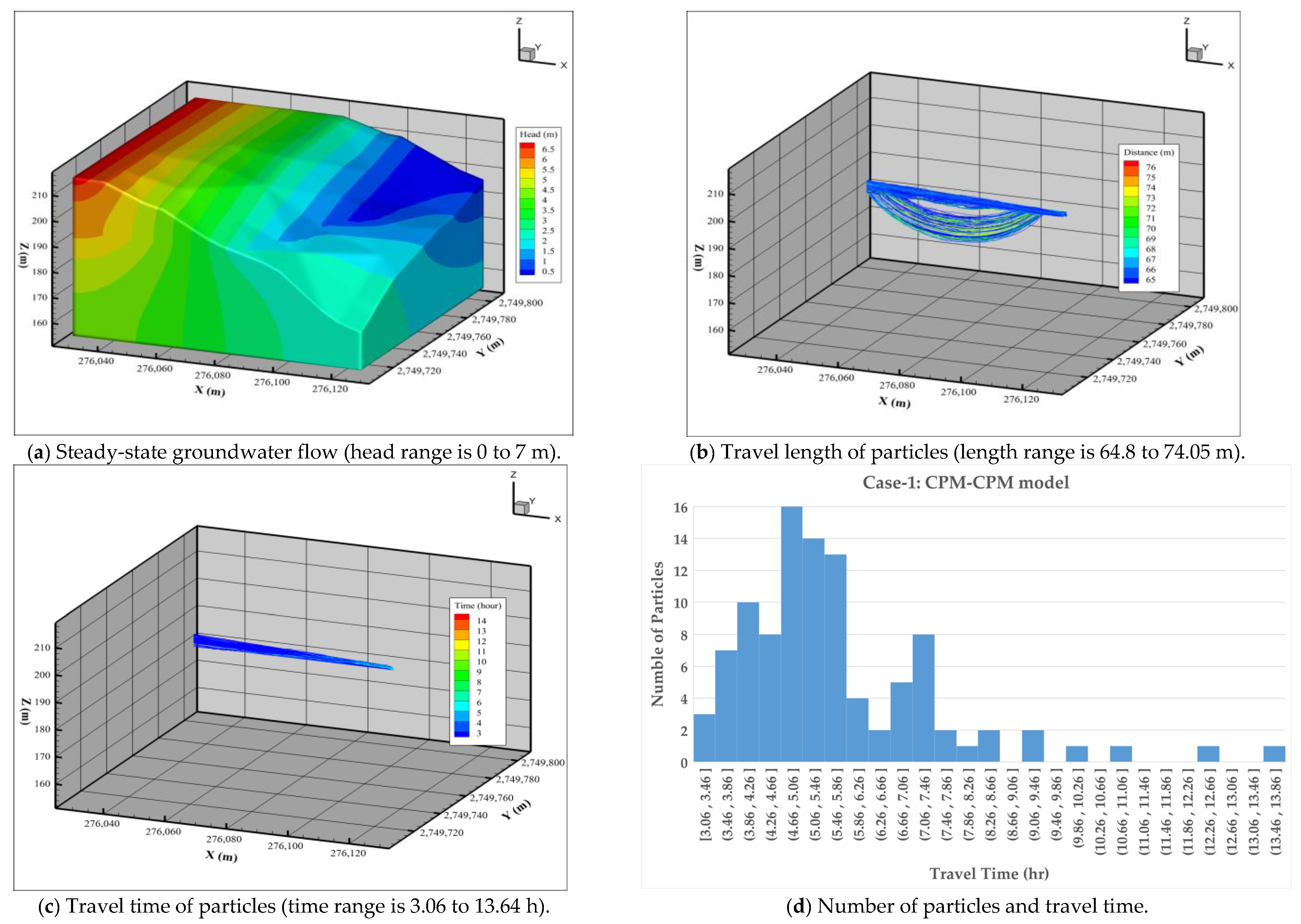
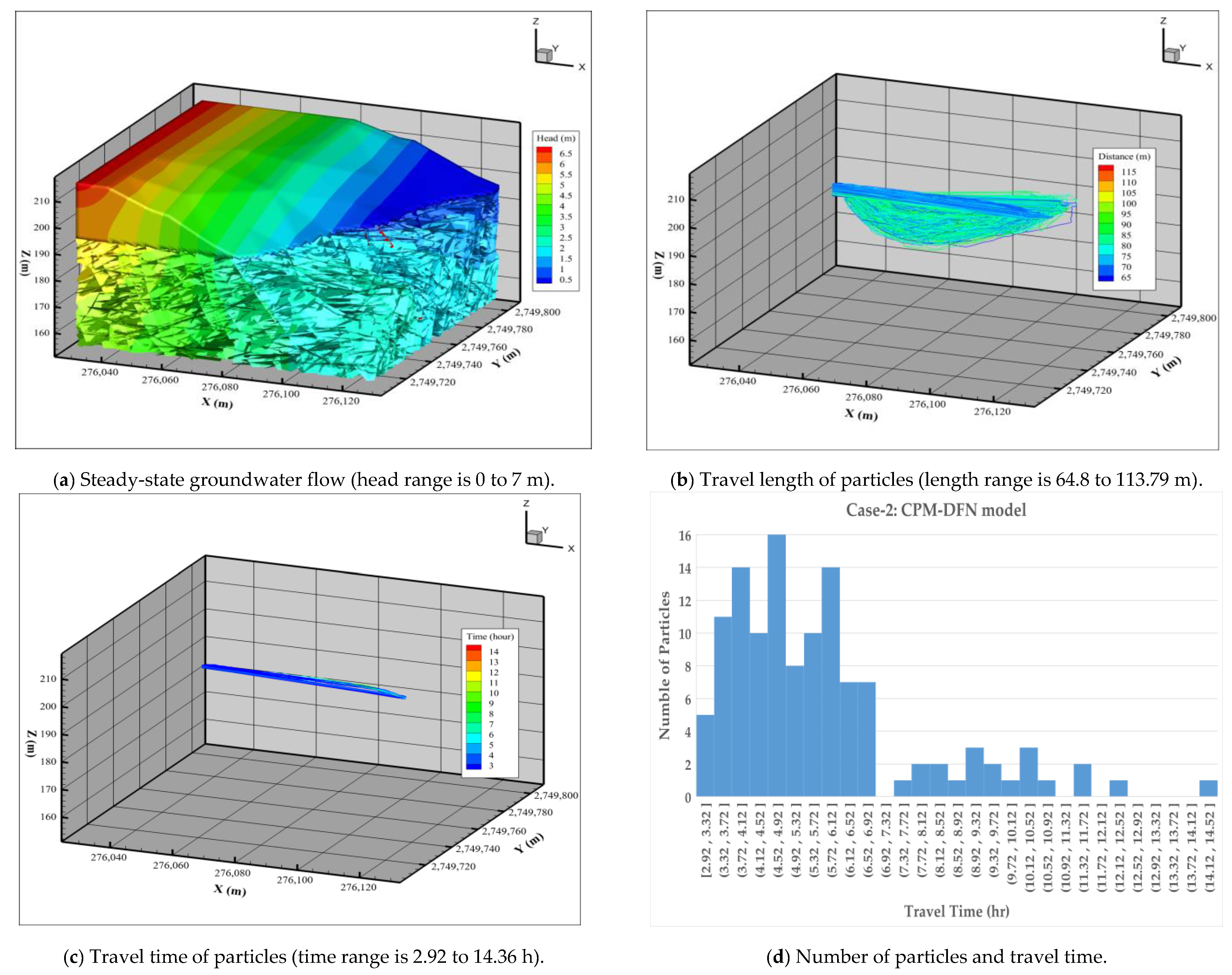
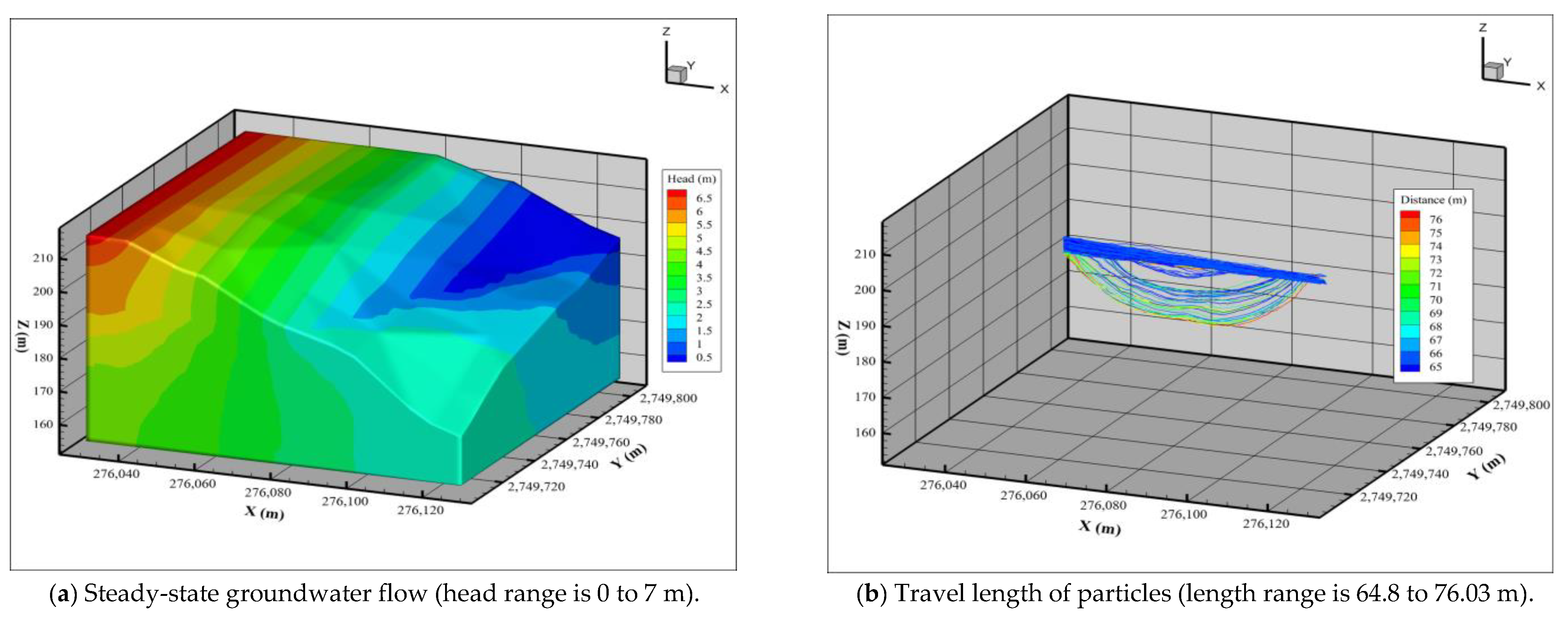
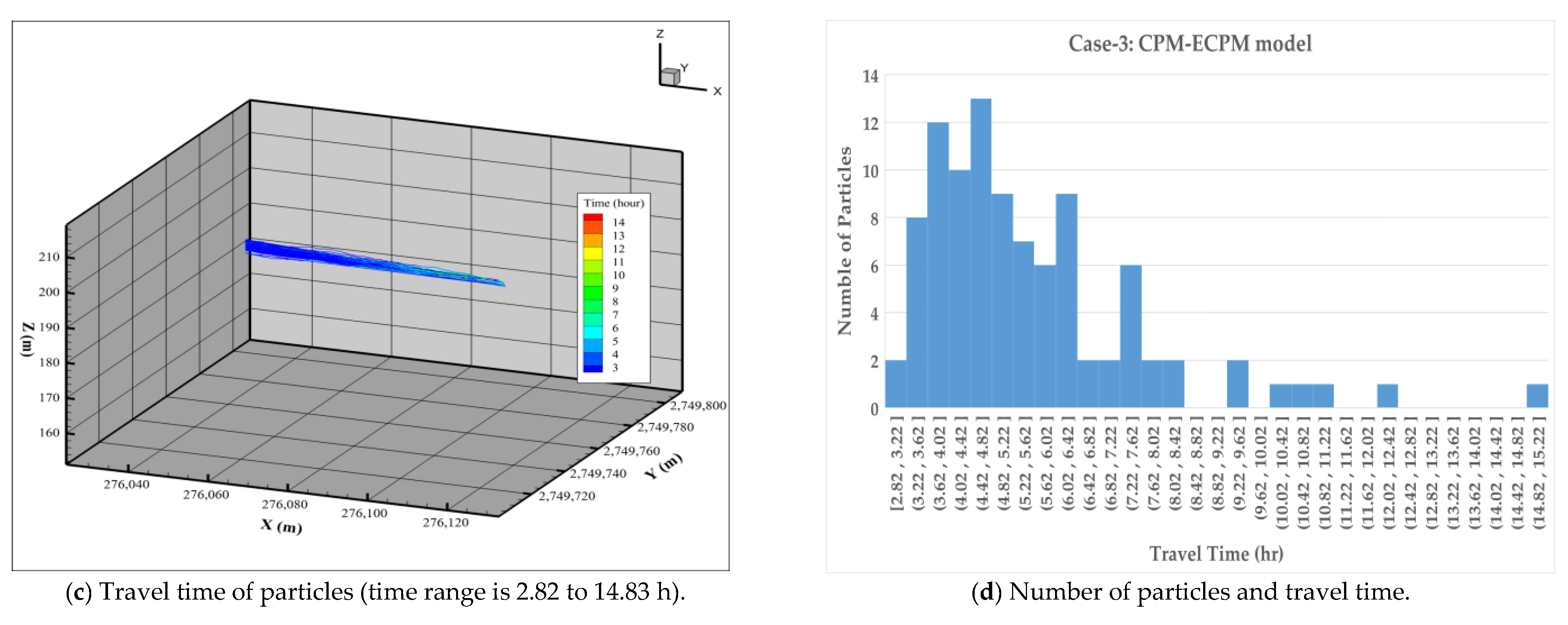
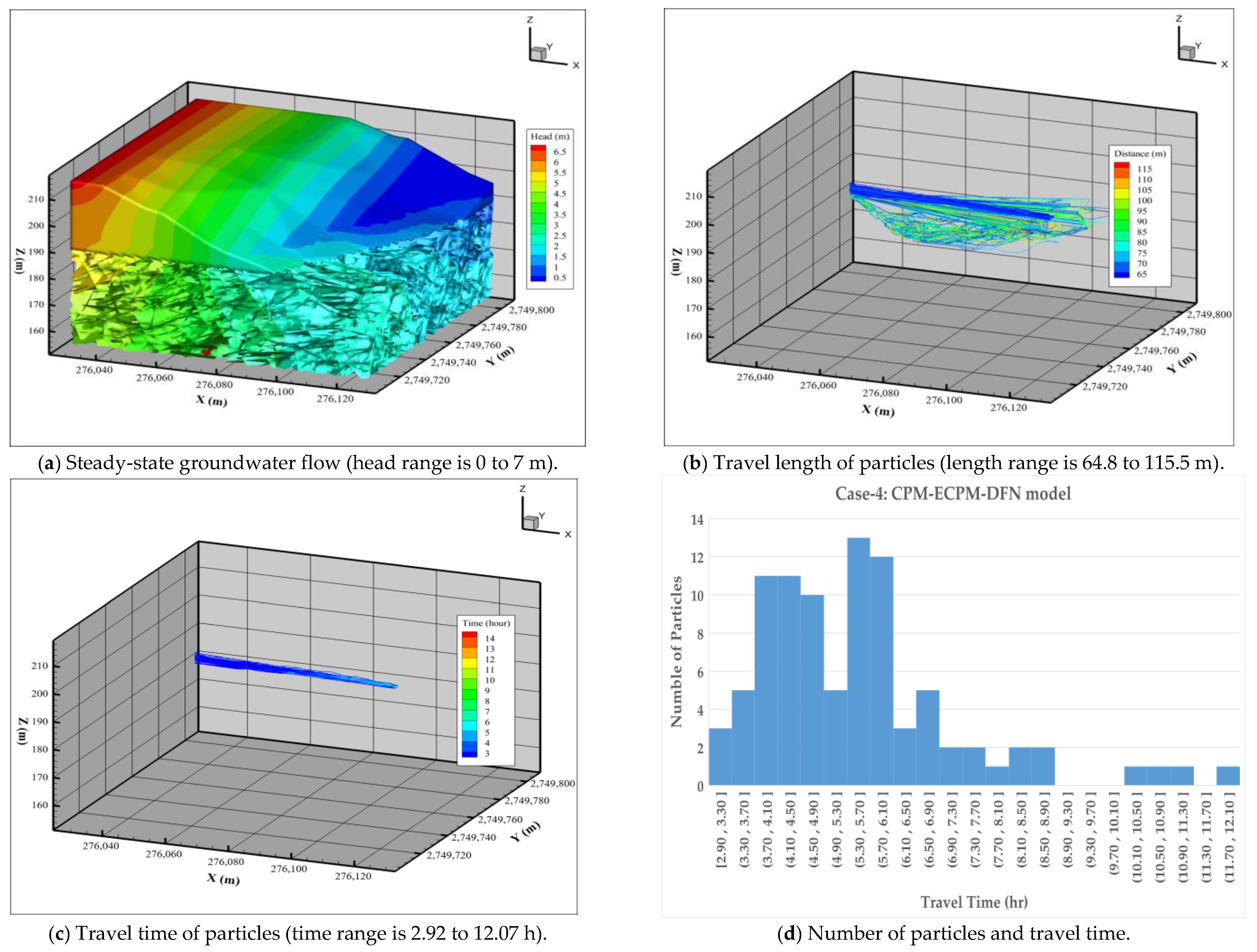

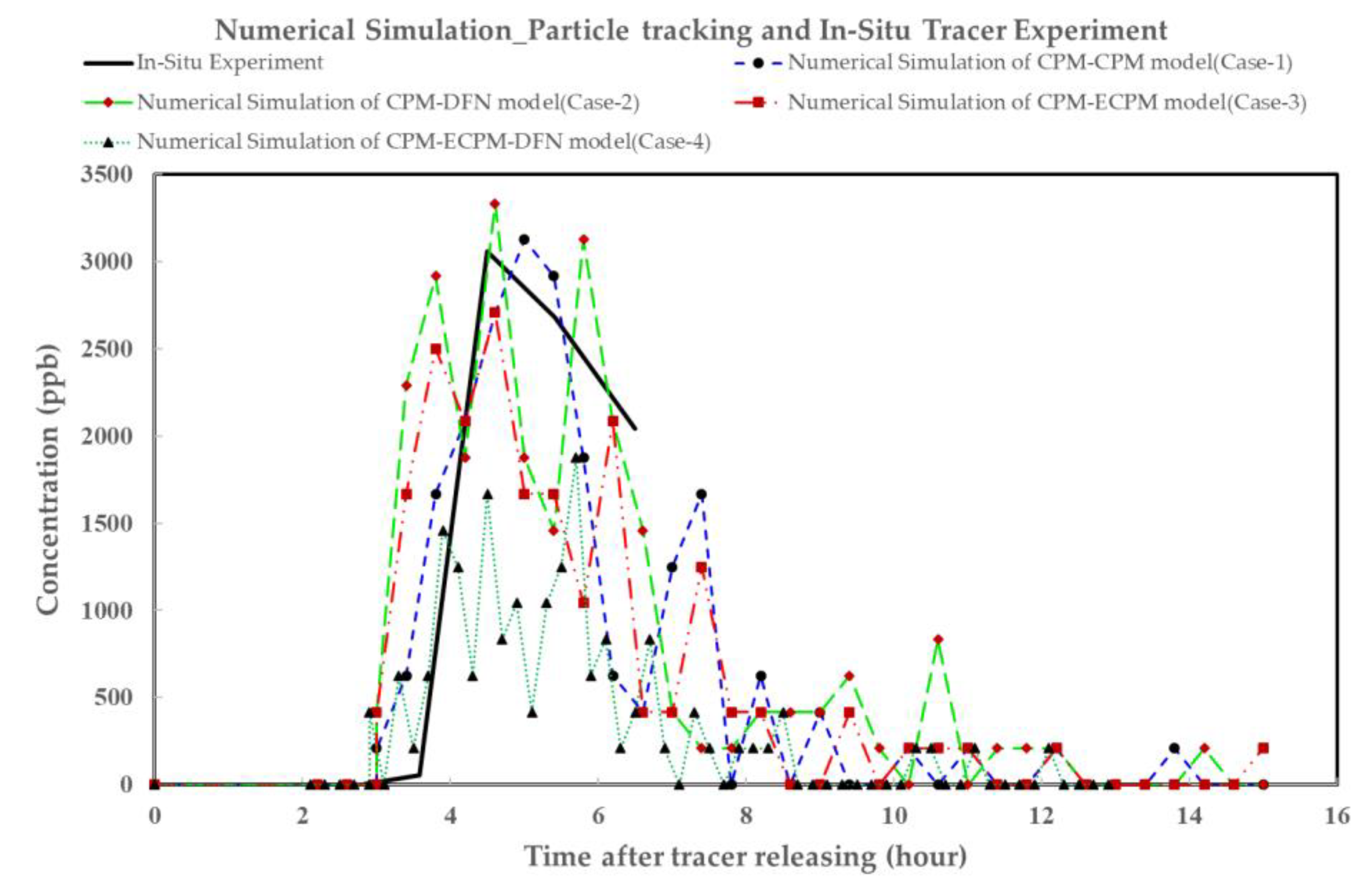
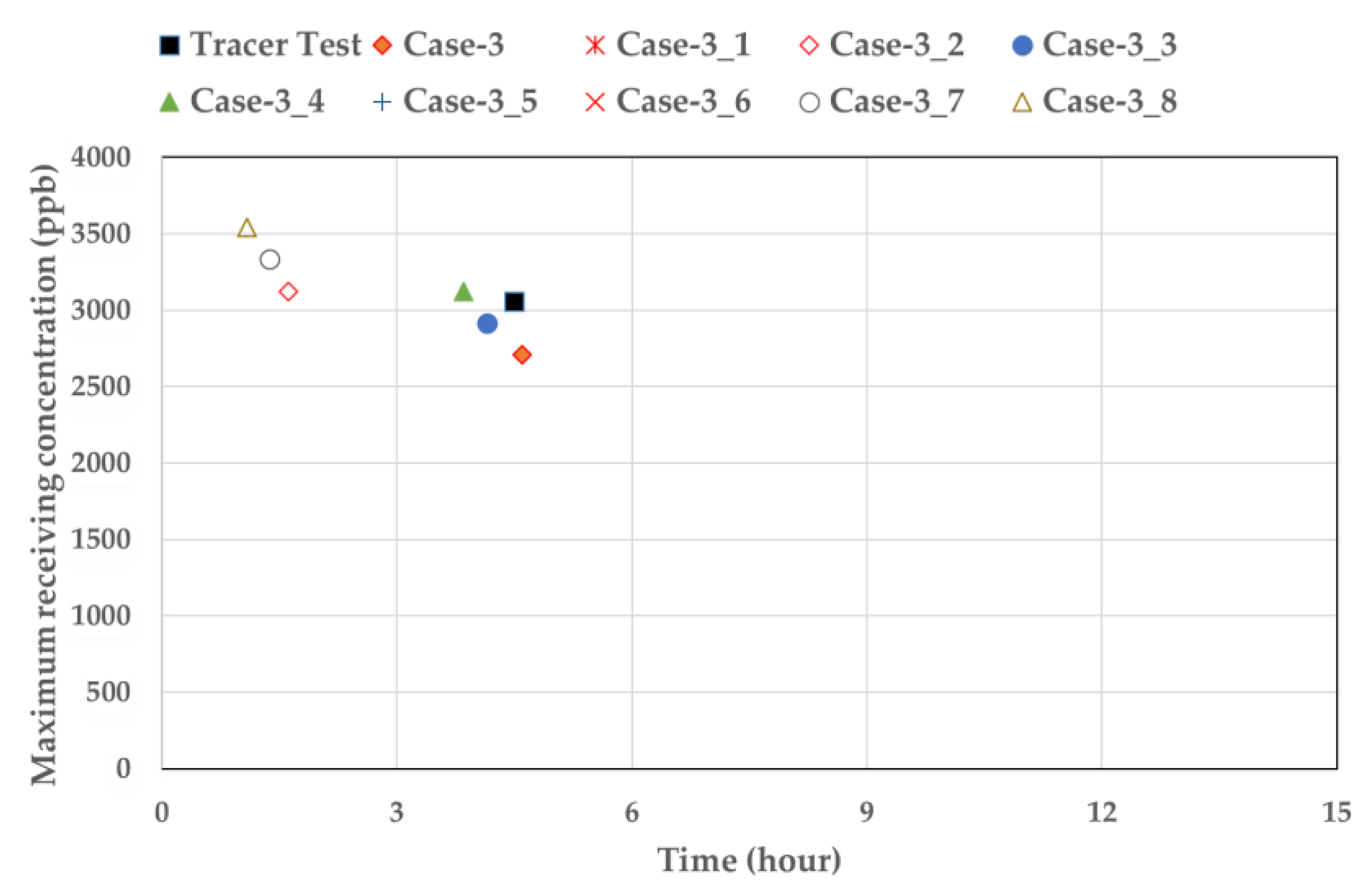
| Rock Matrix | Hydraulic Conductivity (m/s) | ||
|---|---|---|---|
| Minimum | Average | Maximum | |
| Gravel formation | 1.15 × 10−6 | 2.3 × 10−4 | 1.70 × 10−3 |
| Cholan formation | 5.65 × 10−11 | 9.7 × 10−9 | 3.08 × 10−8 |
| DFN Parameter | Parameter Value |
|---|---|
| Fracture cluster (Trend/Plung/Kappa/P32,rel) | Set-1: J1 = 147/62/Fish distribution (κ = 14.43)/ = 55.0% Set-2: B = 331/13/Fish distribution (κ = 50.14)/ = 32.5% Set-3: J2 = 33/39/Fish distribution (κ = 28.49)/ = 12.5% |
| Fracture Intensity, P32 1 | P32 (r 2 > r0) ≈ P10,corr = 1.71 m−1 |
| Fracture Size | Power law: kr = 2.83 3, r0 = 0.1 m 4, rmax = 100 m 5 |
| Fracture Location | Stationary random (Poisson) process |
| Transmissivity | T = 1.0 × 10−9 r0.7 (m2⁄s) |
| Aperture | Doe law: e = 0.5T0.5 (m) |
| Hydrogeological Conceptual Model | Case-1: CPM-CPM Model | Case-2: CPM-DFN Model | Case-3: CPM-ECPM Model | Case-4: CPM-ECPM-DFN Model |
|---|---|---|---|---|
| Number of particles | 938 | 556 | 228 | 472 |
| Minimum length (m) | 64.8 | 64.8 | 64.8 | 64.8 |
| Maximum length (m) | 74.05 | 113.79 | 76.03 | 115.5 |
| Hydrogeological Conceptual Model | Case-1: CPM-CPM Model | Case-2: CPM-DFN Model | Case-3: CPM-ECPM Model | Case-4: CPM-ECPM-DFN Model |
|---|---|---|---|---|
| Number of particles | 101 | 122 | 97 | 91 |
| Minimum time (hours) | 3.06 | 2.92 | 2.82 | 2.90 |
| Maximum time (hours) | 13.64 | 14.36 | 14.83 | 12.07 |
| Hydrogeological Conceptual Model | In Situ Tracer Experiment | Numerical Simulation: Particle Tracking Algorithm | |||
|---|---|---|---|---|---|
| Case-1 CPM-CPM Model | Case-2: CPM-DFN Model | Case-3: CPM-ECPM Model | Case-4: CPM-ECPM-DFN Model | ||
| The earliest time to receive the concentration (hours) | 2.833 | 3.06 | 2.92 | 2.82 | 2.90 |
| Differences from tracer test result (hours) | - | +0.227 | +0.087 | −0.013 | +0.067 |
| Maximum received concentration (ppb) | 3060.343 | 3124.875 | 3333.200 | 2708.225 | 1874.925 |
| Differences from tracer test result (ppb) | - | +64.532 | +272.857 | −352.118 | −1185.418 |
| Time to receive maximum concentration (hours) | 4.50 | 5.00 | 4.60 | 4.60 | 5.70 |
| Differences from tracer test result (hours) | - | +0.5 | +0.1 | +0.1 | +1.2 |
| Case | Hydraulic Conductivity (m/s) | ||
|---|---|---|---|
| Gravel Formation | Cholan Formation | ||
| Integral Rock 1 | Fractured Rock 2 | ||
| Case-3 | 2.3 × 10−4 | Kintegral rock = Kmin 3 = 5.65 × 10−11 | |
| Case-3_1 | 1.15 × 10−6 | Kintegral rock = Kmin = 5.65 × 10−11 | |
| Case-3_2 | 1.70 × 10−3 | Kintegral rock = Kmin = 5.65 × 10−11 | |
| Case-3_3 | 2.3 × 10−4 | Kintegral rock = Kavg 3 = 9.7 × 10−9 | |
| Case-3_4 | 2.3 × 10−4 | Kintegral rock = Kmax 3 = 3.08 × 10−8 | |
| Case-3_5 | 1.15 × 10−6 | Kintegral rock Kavg = 9.7 × 10−9 | |
| Case-3_6 | 1.15 × 10−6 | Kintegral rock = Kmax = 3.08 × 10−8 | |
| Case-3_7 | 1.70 × 10−3 | Kintegral rock = Kavg = 9.7 × 10−9 | |
| Case-3_8 | 1.70 × 10−3 | Kintegral rock = Kmax = 3.08 × 10−8 | |
Disclaimer/Publisher’s Note: The statements, opinions and data contained in all publications are solely those of the individual author(s) and contributor(s) and not of MDPI and/or the editor(s). MDPI and/or the editor(s) disclaim responsibility for any injury to people or property resulting from any ideas, methods, instructions or products referred to in the content. |
© 2024 by the authors. Licensee MDPI, Basel, Switzerland. This article is an open access article distributed under the terms and conditions of the Creative Commons Attribution (CC BY) license (https://creativecommons.org/licenses/by/4.0/).
Share and Cite
Tong, C.-Z.; Yeh, P.; Yu, Y.-C.; Chen, L.-G.; Tseng, H.-H. Verification of Particle Tracking and In Situ Tracer Experiment for the Gravel and Cholan Formation Composite in Northwest Taiwan. Water 2024, 16, 1101. https://doi.org/10.3390/w16081101
Tong C-Z, Yeh P, Yu Y-C, Chen L-G, Tseng H-H. Verification of Particle Tracking and In Situ Tracer Experiment for the Gravel and Cholan Formation Composite in Northwest Taiwan. Water. 2024; 16(8):1101. https://doi.org/10.3390/w16081101
Chicago/Turabian StyleTong, Cong-Zhang, Pin Yeh, Yun-Chen Yu, Liang-Gu Chen, and Han-Hsiang Tseng. 2024. "Verification of Particle Tracking and In Situ Tracer Experiment for the Gravel and Cholan Formation Composite in Northwest Taiwan" Water 16, no. 8: 1101. https://doi.org/10.3390/w16081101





